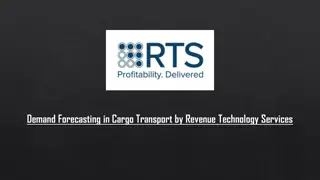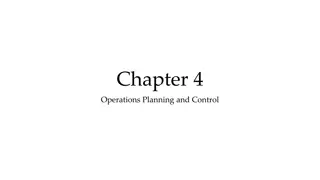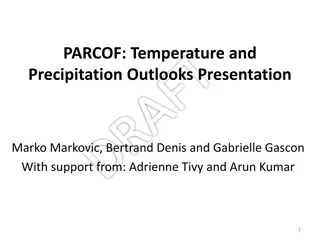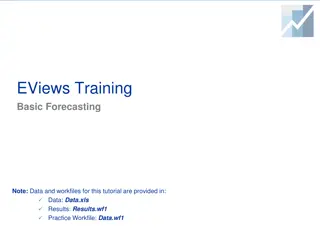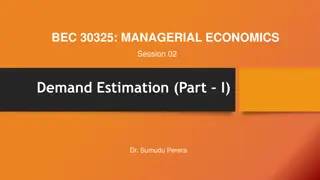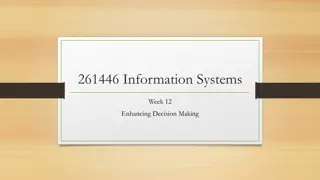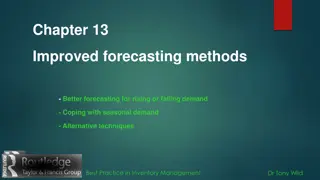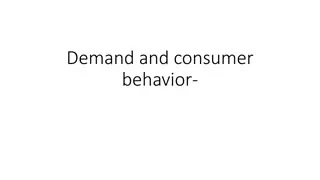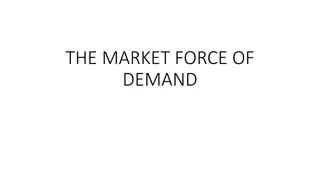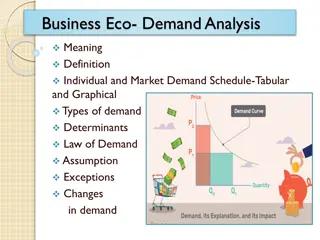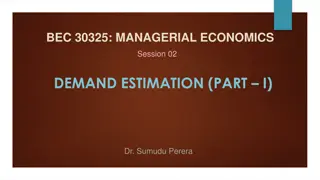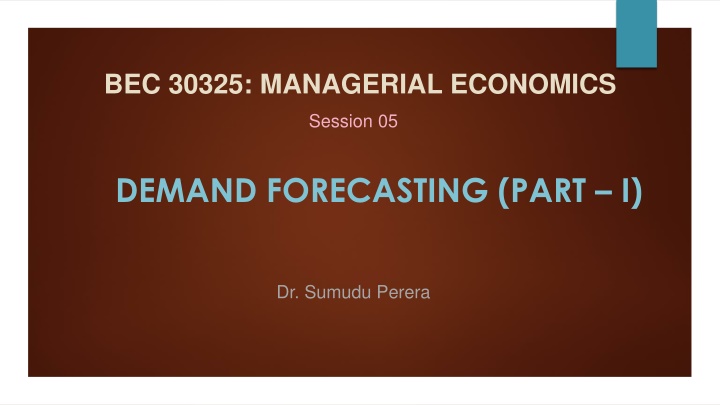
Demand Forecasting in Managerial Decision Making
Forecasting plays a crucial role in reducing risk and uncertainty for businesses, aiding in short-term operational decision-making and long-term growth planning. Both micro and macro forecasting methods are utilized, with techniques ranging from qualitative to quantitative approaches based on past data or complex models, assisting firms in optimizing resource allocation and strategic planning.
Download Presentation

Please find below an Image/Link to download the presentation.
The content on the website is provided AS IS for your information and personal use only. It may not be sold, licensed, or shared on other websites without obtaining consent from the author. If you encounter any issues during the download, it is possible that the publisher has removed the file from their server.
You are allowed to download the files provided on this website for personal or commercial use, subject to the condition that they are used lawfully. All files are the property of their respective owners.
The content on the website is provided AS IS for your information and personal use only. It may not be sold, licensed, or shared on other websites without obtaining consent from the author.
E N D
Presentation Transcript
BEC 30325: MANAGERIAL ECONOMICS Session 05 DEMAND FORECASTING (PART I) Dr. Sumudu Perera
Session Outline 2 Forecasting Qualitative Forecasts Time -Series Analysis Trend projection Seasonal Variation Smoothing Techniques Barometirc forecasting Input Output Forecasting Dr.Sumudu Perera 15/03/2025
Forecasting There is a risk and uncertainty in the business environment Managers need to utilize limited resources to gain optimum benefit They have to foresee the future They have to plan for the future Forecasting is an important part of managerial decision making as business decisions involve a great deal of uncertainty.
Objectives of Demand Forecasting Reduce risk and uncertainty that the firms face in short term operational decision making Reduce risk and uncertainty that the firm faces in planning for long term growth
Micro and Macro forecasting Macro forecasts is the forecasting of general economic condition Ex: economic growth, price level changes These forecasts are made by economists, central bank, policy makers They show the future changes based on the historical data and expected changes in the domestic and international conditions
Micro forecasts Micro forecast means forecasting of the demand or sales of a firm These are based on historical market share of the firm and planned marketing strategy These forecasts are used to forecast the firms operational needs: ex: raw material, equipment, warehousing, labour Firms use long term forecast to forecast expenditure on plant and equipment to meet its long term growth plan and strategy
Forecasting Techniques Qualitative Techniques Quantitative Techniques Based on only past data Use of complex models based on a large set of additional data and relationships Performed by the firm Performed by consulting firms Useful for short term Useful for long term
Qualitative Forecast Usefulness: Qualitative Forecast techniques Surveys Opinion polls Market Experiments
9 Opinion Polls Forecasts are done based on the opinions of the experts within or outside the firm. To control the subjective nature of the personal insights, polling is used. Hence, average forecast of the group is used as the forecast There are different Polling techniques Dr.Sumudu Perera 15/03/2025
Executive Polling Forecasting based on the polls of the experts in the field Top management of the firm or outside experts can be used Personnel in the top management are experts with a very good experience about the firm Outside experts have the knowledge about the market and having a free thinking Collective judgement entirely based on insights of those with a knowledge of the industry.
Sales force Polling Forecast is based on the opinions of sales force in the field Advantages Sales force is the closest group to the market They get the responses from the market They can make a better prediction about the firm s demand, competing brands in the market and identify changes going on
Consumer Intension Polling Forecasts based on the responses of potential buyers Interview the potential buyers to get their purchasing intensions Advantages: Their polls are used to make the forecast These consider the future expectations of the consumers Forecasts based on the consumers own opinions, requirements, choices
13 SURVEYS Survey of consumer plans generate useful data. Commonly use when introducing a new product or making a substantial changes to existing one. When no data available for forecast, survey on anticipated demand Surveys of economic activity . Value of surveys depend on Surveys can use as supplementary information for decision making Dr.Sumudu Perera 15/03/2025
14 MARKET EXPERIMENTS Usually to overcome weakness of consumer surveys. Generate data prior to full scale introduction of a product or implementation of a policy. Usually done in a test market and experiment may involve several features Evaluating consumer perceptions Determine demand elasticity Test reaction to a new advertising campaign are of relatively short durations, customers not fully aware of pricing and advertising changes Dr.Sumudu Perera 15/03/2025
Quantitative Forecasting Quantitative forecasting methods use statistical techniques to forecast demand They consider the time series trend, impact of different factors, potential changes in the market Main quantitative methods: Time Series Analysis Smoothing Techniques Barometric Methods
16 Time -Series Analysis: Forecast based on the analysis of time-series data Time Series data: values arranged by days, weeks, years Plot past data, examine the trend, forecast the future Assumption: Past trend will remain in the future when changes in a variable shows a clear pattern over time, this is appropriate. Fluctuations in Time Series Data Reasons: Secular trend long run changes Cyclical fluctuations cyclical pattern Seasonal variations- regular fluctuations Irregular influences Dr.Sumudu Perera 15/03/2025
17 TREND PROJECTION Trend Projection Trend Projection: Commonly used technique of forecasting. Assume there is a identifiable trend in data. Project the past trend by fitting a line and extend it to forecast. Methods Graphical curve fitting: Graphical curve fitting: free hand method. 1. 1. Limitation: accuracy depends on the analysts ability to fit a curve to data Statistical curve fitting Statistical curve fitting: use regression to fit a curve. 2. 2. = + S S S S bt bt t t o o Constant rate of change(Linear : Constant rate of change(Linear : assume sales increase by a constant rate from one period to next Dr.Sumudu Perera 15/03/2025
Example Time Period 2010 Quarter 1 2 3 4 1 2 3 4 1 2 3 4 1 2 3 4 T 1 2 3 4 5 6 7 8 9 Sales 11 15 12 14 12 17 13 16 14 18 15 17 15 20 16 19 2011 2012 10 11 12 13 14 15 16 2013
Seasonal Variation Improve the forecast by incorporating the seasonal variations Methods: Ratio to trend; dummy variable method 1. Ratio 1. Ratio- -to to- -Trend method Trend method Actual Ratio = Trend Forecast Average of Ratios for Each Seasonal Period Seasonal Adjustment = = Adjusted Forecast Trend Forecast Seasonal Adjustment
Seasonal Variation Ratio to Trend Method: Example Calculation for Quarter 1 Trend Forecast 2010.1 12.29 2011.1 13.87 2012.1 15.45 2013.1 17.02 Seasonal Adjustment = Year Actual 11.00 12.00 14.00 15.00 Ratio 0.8950 0.8652 0.9061 0.8813 0.8869 Trend Forecast for 2014.1 = 11.90 + (0.394)(17) = 18.60 Seasonally Adjusted Forecast for 2014.1 = (18.60)(0.8869) = 16.50
Smoothing Techniques Predicts value of a time series on the basis of some average of its past value only . Smoothing techniques are useful when the time series exhibit little trend or seasonal variations but a great deal of irregular or random variations
Moving Average Forecasts Forecast is the average of data from w periods prior to the forecast data point. w A = t i w F t = 1 i
23 Exponential Smoothing: Trend projection places equal weight on all data point in the estimation No problem if no or little change in the trend over entire series / period If recent observations are more accurate and influential than past, accuracy may be at stake Exponential smoothing gives greater weight to more recent observation Dr.Sumudu Perera 15/03/2025
24 Barometirc forecasting Barometric Forecasting: Trend projection and exponential smoothing use past relationship to predict future If no clear pattern in a time series, data have little value for forecasting One way to forecast or anticipate short-term changes in economic activity or turning points in business cycle is to use the index of leading economic indicators. Dr.Sumudu Perera 15/03/2025
Input Output Forecasting A firm can also forecast sales by using input-output tables Input output table examines the interdependence among various industries and sectors of the economy. It shows the use of the output of each industry as inputs by other industries and for final consumption Since ,this method is time consuming and highly cost associated firms used secondary data



